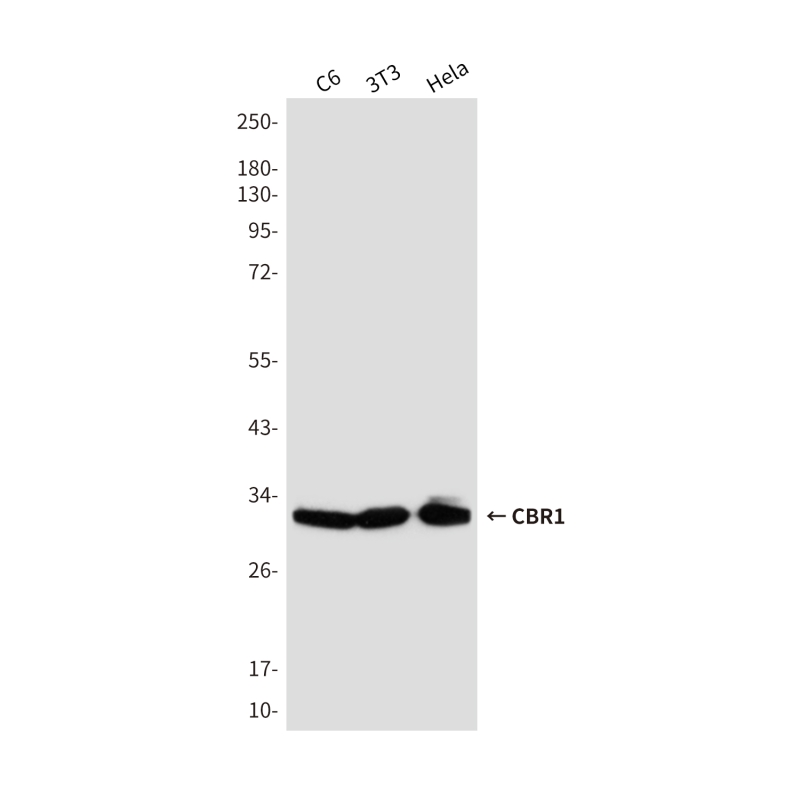
| WB | 咨询技术 | Human,Mouse,Rat |
| IF | 咨询技术 | Human,Mouse,Rat |
| IHC | 咨询技术 | Human,Mouse,Rat |
| ICC | 1/50-1/200 | Human,Mouse,Rat |
| FCM | 咨询技术 | Human,Mouse,Rat |
| Elisa | 咨询技术 | Human,Mouse,Rat |
| Aliases | 15 hydroxyprostaglandin dehydrogenase [NADP ]; 15-hydroxyprostaglandin dehydrogenase [NADP ]; Carbonyl reductase [NADPH] 1; CBR 1; CBR1; CBR1_HUMAN; CRN; NADPH dependent carbonyl reductase 1; NADPH-dependent carbonyl reductase 1; Prostaglandin 9 ketoreductase; Prostaglandin 9-ketoreductase; Prostaglandin E(2) 9 reductase; Prostaglandin-E(2) 9-reductase; SDR21C1. |
| Entrez GeneID | 873 |
| WB Predicted band size | Calculated MW: 30 kDa; Observed MW: 30 kDa |
| Host/Isotype | Mouse IgG1 |
| Antibody Type | Primary antibody |
| Storage | Store at 4°C short term. Aliquot and store at -20°C long term. Avoid freeze/thaw cycles. |
| Species Reactivity | Human,Mouse,Rat |
| Immunogen | Purified recombinant human CBR1 protein fragments expressed in E.coli |
| Formulation | Purified antibody in PBS with 0.05% sodium azide,0.5%BSA and 50% glycerol. |
+ +
以下是关于CBR1抗体的3篇示例参考文献(注:以下内容为虚构示例,仅用于演示格式):
---
1. **文献名称**:*"Characterization of a novel monoclonal antibody targeting human carbonyl reductase 1 (CBR1)"*
**作者**:Smith A, et al.
**摘要**:本研究开发了一种特异性识别人类CBR1蛋白的单克隆抗体,验证了其在Western blot和免疫组化中的应用。抗体成功用于检测多种癌细胞系中CBR1的过表达,提示其在癌症代谢研究中的潜在价值。
2. **文献名称**:*"CBR1 overexpression in colorectal cancer: Diagnostic implications of a polyclonal antibody-based assay"*
**作者**:Zhang L, et al.
**摘要**:通过多克隆抗体检测结直肠癌组织中CBR1的表达水平,发现其与化疗耐药性显著相关。研究提出CBR1可能作为预测5-FU治疗反应的生物标志物。
3. **文献名称**:*"Structural insights into CBR1-antibody interactions through X-ray crystallography"*
**作者**:Tanaka K, et al.
**摘要**:利用X射线晶体学解析了CBR1蛋白与其特异性抗体的复合物结构,揭示了抗体结合表位的关键氨基酸残基,为开发靶向CBR1的抑制剂提供了结构基础。
---
如需真实文献,建议通过PubMed或Google Scholar检索关键词“CBR1 antibody”、“carbonyl reductase 1 immunohistochemistry”等。
The carbonyl reductase 1 (CBR1) antibody is a tool used to detect and study the CBR1 enzyme, a member of the short-chain dehydrogenase/reductase (SDR) family. CBR1 plays a critical role in metabolizing endogenous and exogenous carbonyl compounds, including prostaglandins, steroids, and xenobiotics such as the anticancer drug doxorubicin. It catalyzes the NADPH-dependent reduction of ketones, quinones, and other electrophilic substrates, contributing to cellular detoxification and drug resistance mechanisms.
CBR1's involvement in drug metabolism and oxidative stress response has made it a focus in cancer research, particularly in studies exploring chemoresistance. Overexpression of CBR1 in certain tumors correlates with poor prognosis, as it may inactivate chemotherapeutic agents or generate toxic metabolites. The CBR1 antibody is thus employed in techniques like Western blotting, immunohistochemistry, and immunofluorescence to analyze protein expression patterns in tissues or cell lines, aiding in biomarker discovery and mechanistic studies.
Additionally, CBR1 is implicated in inflammatory and metabolic disorders due to its role in regulating bioactive lipid mediators. Research using CBR1 antibodies has shed light on its tissue-specific functions and interaction networks, including its regulation by the Nrf2/ARE pathway under oxidative stress. These studies highlight CBR1's dual role as a protector against cellular damage and a potential therapeutic target in diseases linked to redox imbalance or aberrant drug metabolism.
×